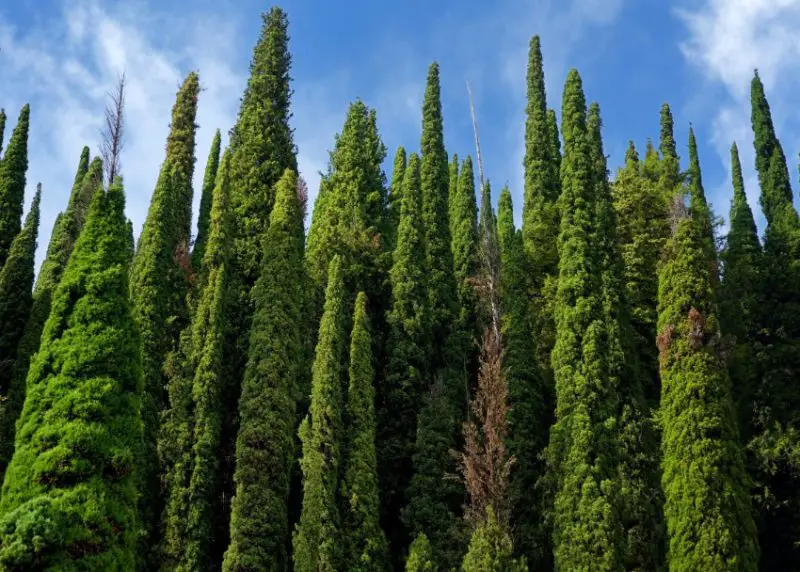Cypress trees are a majestic plant known for their elegant, conical shape and adaptability to various growing conditions. Whether you’re looking to create a stately privacy screen or add an ornamental feature to your garden, learning how to plant, grow, and care for cypress trees will ensure your trees thrive for generations.
In this most detailed guide, we’ll explore everything you need to know about Cypress tree care, from selecting the right species to maintaining them year-round.
About Cypress Trees

Cypress trees belong to the Cupressaceae family and are native to a variety of regions, including North America, Europe, and Asia. With their characteristic needle-like leaves and woody cones, cypress trees are typically evergreen, maintaining their lush greenery throughout the year. Cypress species range from towering giants like the Monterey Cypress (Cupressus macrocarpa) to smaller varieties like the Bald Cypress (Taxodium distichum), which is known for its unique ability to thrive in swampy areas.
Different Types of Cypress Trees
There are several popular species of cypress trees, each suited for different climates and landscape needs:
- Leyland Cypress (Cupressus × leylandii): A hybrid variety known for its rapid growth, making it perfect for privacy screens and windbreaks.
- Bald Cypress (Taxodium distichum): A deciduous cypress that sheds its leaves in the fall, often found in wet, swampy environments. Its unique “knees” grow above the water’s surface.
- Monterey Cypress (Cupressus macrocarpa): Native to the coast of California, this tree is known for its resilience to salt spray and windy conditions.
- Italian Cypress (Cupressus sempervirens): Famous for its tall, narrow form, the Italian Cypress is often used in Mediterranean-style landscapes.
Each of these cypress tree varieties has distinct characteristics that can enhance your garden or landscape, depending on your region and the look you want to achieve.
How to Plant Cypress Trees
When to Plant Cypress Trees
The best time to plant cypress trees is in the early spring or fall, when temperatures are cooler, and the tree has time to establish its roots before extreme weather conditions. Fall planting is especially ideal in warmer climates, giving the tree time to grow strong roots before the heat of summer.
Where to Plant Cypress Trees
Cypress trees thrive in locations with plenty of sunlight and well-drained soil. While some species, like the Bald Cypress, can tolerate wet conditions, most cypress varieties prefer slightly acidic, moist, but well-drained soils.
- Sunlight: Cypress trees do best in full sun, needing at least six hours of direct sunlight per day.
- Soil: Most cypress trees thrive in a range of soil types, but the key is ensuring the soil is well-drained. For species like the Leyland Cypress, avoid areas with heavy clay soil that retains water.
How to Plant Cypress Trees
Follow these steps to ensure your cypress trees establish strong roots and grow successfully:
- Prepare the planting site: Dig a hole that is twice the width of the tree’s root ball but only as deep as the root ball itself.
- Loosen the soil: Ensure the soil around the hole is loose to encourage root expansion.
- Plant the tree: Place the tree in the hole, making sure the top of the root ball is slightly above ground level. This prevents water from pooling around the base of the tree.
- Backfill and water: Backfill the hole with the original soil, tamp it down gently, and water thoroughly to eliminate air pockets.
- Mulch: Spread a 2-3 inch layer of mulch around the base of the tree, keeping it a few inches away from the trunk to prevent rot. Mulching helps retain moisture and regulate soil temperature.
Spacing for Cypress Trees
If you’re planting multiple cypress trees, especially for a hedge or windbreak, it’s essential to space them correctly. Leyland Cypress, for example, should be spaced 6-10 feet apart to allow for growth and air circulation. Proper spacing will reduce the risk of disease and ensure that each tree has enough room to grow to its full potential.
How to Care for Cypress Trees
Watering Cypress Trees
Watering is crucial for newly planted cypress trees. Keep the soil consistently moist during the first year, especially in dry periods. Once established, most cypress trees are drought-tolerant but will benefit from occasional deep watering, especially during hot, dry summers.
- Newly planted trees: Water deeply once or twice a week, ensuring the soil remains moist but not waterlogged.
- Established trees: Once the tree matures, reduce watering to once every two to three weeks, depending on rainfall and climate conditions.
Fertilizing Cypress Trees
Cypress trees generally don’t require much fertilization, but feeding them with a balanced fertilizer can encourage faster growth, particularly in their early years. Apply a slow-release, balanced fertilizer in the spring before new growth begins. For best results, look for a fertilizer labeled 10-10-10 (nitrogen, phosphorus, potassium).
Pruning Cypress Trees
Pruning cypress trees is typically unnecessary, as they naturally maintain their conical shape. However, you may want to prune them lightly to remove dead or diseased branches, especially in Leyland Cypress or Italian Cypress hedges.
- Light pruning: Trim back any dead or damaged branches in late winter or early spring before new growth starts.
- Shaping: If using cypress trees for a formal hedge, lightly trim the tops and sides once a year to maintain the desired shape.
Common Pests and Diseases
Although cypress trees are relatively resistant to pests and diseases, they can occasionally suffer from problems such as bagworms, spider mites, or root rot. Maintaining healthy trees through proper watering, fertilizing, and spacing will minimize these risks.
- Bagworms: These pests create silk bags on branches and can defoliate trees if left unchecked. Remove bagworms manually or apply an insecticide.
- Spider mites: Look for yellowing or browning needles as signs of an infestation. Treat with insecticidal soap or horticultural oil.
- Root rot: Often caused by poor drainage, root rot can be prevented by planting cypress trees in well-drained soil.
Cypress Tree Propagation
Cypress trees can be propagated from seeds or cuttings. Cuttings are generally the preferred method, as they produce genetically identical trees and are faster to establish.
Propagating from Cuttings
- Take cuttings: In late summer or early fall, select a healthy, semi-hardwood branch and take a cutting about 6-8 inches long.
- Prepare the cutting: Remove the lower leaves and dip the cut end in rooting hormone.
- Plant the cutting: Place the cutting in a container filled with moist, well-draining soil mix. Cover with a plastic dome to retain humidity.
- Care for the cutting: Keep the cutting in indirect light and mist regularly to keep the soil moist. Roots should develop within a few months.
Propagating from Seeds
While it is possible to grow cypress trees from seeds, this method is slower and less reliable. Collect seeds from mature cones in the fall, and plant them in a well-drained soil mix. Keep the seeds moist and in a cool environment until germination, which can take several months.
Landscaping with Cypress Trees
Cypress trees offer versatility in landscape design, whether you’re creating a formal garden or a naturalistic setting. Here are some ideas for using cypress trees in landscaping:
- Privacy screens: Fast-growing species like Leyland Cypress make excellent hedges and windbreaks.
- Ornamental trees: Tall, narrow varieties like Italian Cypress are perfect for framing entrances or driveways.
- Wet areas: Bald Cypress is ideal for planting in swampy or waterlogged areas, adding a unique architectural element to ponds or streams.
Conclusion
Cypress trees are a beautiful and hardy addition to any landscape, offering year-round greenery and versatile landscaping potential. Whether you’re planting them as a privacy screen, a windbreak, or simply as a striking focal point, following these cypress tree care and growing tips will ensure that your trees remain healthy and vibrant. From choosing the right species to planting, watering, and pruning, this guide provides everything you need to know to grow thriving cypress trees for years to come.
Start planting your cypress trees today and enjoy the timeless elegance and beauty that these ancient trees bring to your outdoor space.






